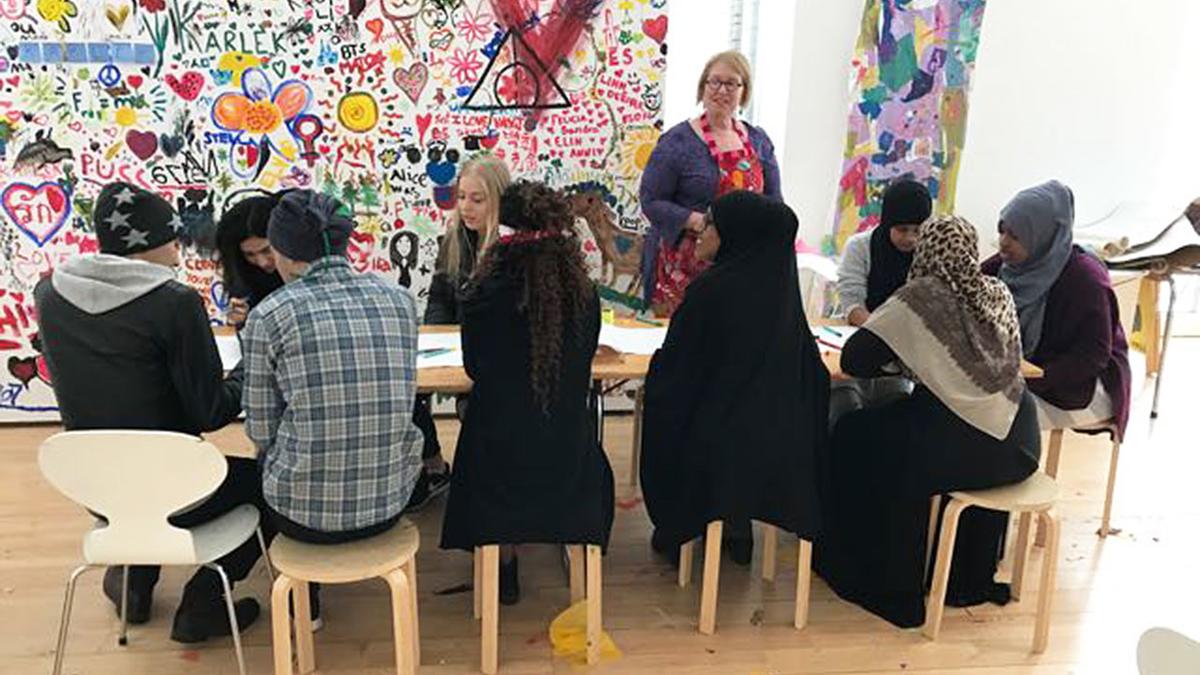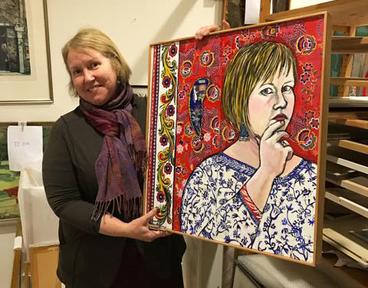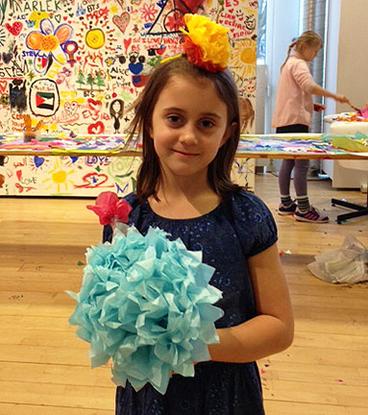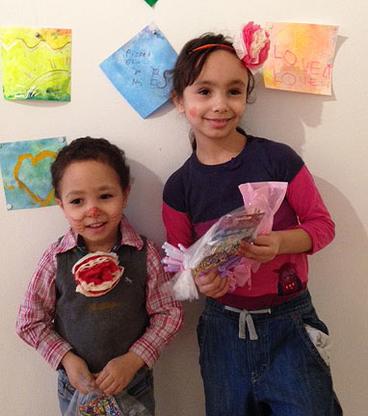Faculty research is rarely a stand-alone exercise. Knowledge and experience is brought back to the classroom, making lessons deeper and richer. For UMD Art Education Professor Alison Aune, recent experiences in Växjö, Sweden will inform her teaching for years to come.
Aune recently joined artist Anne Labovitz in Växjö, as part of Labovitz’s ongoing "122 Conversations: Person to Person, Art Beyond Borders” project. “I have been going to Växjö almost every year since 1996, when I first went as the museum educator for the Tweed Museum of Art, and I have continued to develop cross-cultural dialogues with faculty and staff at Konsthall art museum and Linnaeus University where I spent a semester as a Fulbright Scholar in 2009," Aune says. "I thought I could help Anne develop exhibition programming and involve Swedish art education students to help with the workshops."
On her website, Labovitz describes the "122 Conversations" project as "an artist-led project, based on the art of engagement — art derived from the process of interconnection and cross-cultural dialogue."
The project is organized by UMD’s Tweed Museum of Art, in collaboration with Duluth Sister Cities International and UMD’s School of Fine Arts and integrates Duluth’s five Sister Cities: Rania, Iraqui Kuridastna; Petrozavodsk, Russia; Thunder Bay, Canada; Ohara-Isumi City, Japan; and Växjö, Sweden. Aune is a Duluth Sister Cities International Board member and also joined Labovitz to celebrate 30 years as Sister Cities.
Labovitz has been traveling to these cities, creating art, and conducting workshops. The “122 Conversations” project will culminate with a major exhibition at the Tweed Museum in 2018.
Labovitz and Aune’s goal in Växjö was to promote artistic creativity and inclusive cross-cultural learning through workshops with children and youth. What they hadn’t expected were the refugees.
Last year, Sweden took in more refugees per capita than any other European country. “The week that we got there, refugees from Syria, Somalia, Afghanistan, and Saudi Arabia had moved from temporary quarters to a hotel in Växjö,” Aune says. "A friend, who had been visiting them with the Red Cross, described the isolation, disconnect and sorrow people felt."
Aune and Labovitz knew that they could help the situation in a small way. "We invited the refugee families to the Konsthall's Family Day. Invitations were sent and preparations were made."
Children and their mothers made art. Images communicated feelings. "Creating together, we created harmony and healing. The Konsthall was filled with happiness, celebration, and friendship.”
When the Family Day event was over, Aune and Labovitz gave children art supplies to take with them so that creating could continue. “On that day, we were ambassadors of peace,” Aune says. Filppa de Vos, director of the Konsthall, said that she will continue to work with the refugee families in Växjö.
In November 2017, Aune and Labovitz will present 122 Conversations: Art Workshops in Sweden at the annual Art Educators of Minnesota conference. Aune says that she wants to share her experiences of international engagement, interconnectedness, and cross-cultural dialogue. “Art needs to be for everybody. We have to find ways to nourish the creative imaginations of all children, especially marginalized and immigrant groups.”
Aune will share her experiences with her art education students, and in May 2018, she will take UMD Art and Design students to Växjö (the third time she's taken students to that destination).
For the students who will take part in that trip, Aune hopes that it will "promote international curiosity in my students so that they will become engaged and motivated artist-educators who are culturally sensitive, inclusive, and tolerant teachers who exercise social responsibility through civic engagement. We can promote meaningful relationships through art."
Visit UMD’s Art Education program website.
Aune recently joined artist Anne Labovitz in Växjö, as part of Labovitz’s ongoing "122 Conversations: Person to Person, Art Beyond Borders” project. “I have been going to Växjö almost every year since 1996, when I first went as the museum educator for the Tweed Museum of Art, and I have continued to develop cross-cultural dialogues with faculty and staff at Konsthall art museum and Linnaeus University where I spent a semester as a Fulbright Scholar in 2009," Aune says. "I thought I could help Anne develop exhibition programming and involve Swedish art education students to help with the workshops."
On her website, Labovitz describes the "122 Conversations" project as "an artist-led project, based on the art of engagement — art derived from the process of interconnection and cross-cultural dialogue."
The project is organized by UMD’s Tweed Museum of Art, in collaboration with Duluth Sister Cities International and UMD’s School of Fine Arts and integrates Duluth’s five Sister Cities: Rania, Iraqui Kuridastna; Petrozavodsk, Russia; Thunder Bay, Canada; Ohara-Isumi City, Japan; and Växjö, Sweden. Aune is a Duluth Sister Cities International Board member and also joined Labovitz to celebrate 30 years as Sister Cities.
Labovitz has been traveling to these cities, creating art, and conducting workshops. The “122 Conversations” project will culminate with a major exhibition at the Tweed Museum in 2018.
Labovitz and Aune’s goal in Växjö was to promote artistic creativity and inclusive cross-cultural learning through workshops with children and youth. What they hadn’t expected were the refugees.
Last year, Sweden took in more refugees per capita than any other European country. “The week that we got there, refugees from Syria, Somalia, Afghanistan, and Saudi Arabia had moved from temporary quarters to a hotel in Växjö,” Aune says. "A friend, who had been visiting them with the Red Cross, described the isolation, disconnect and sorrow people felt."
Aune and Labovitz knew that they could help the situation in a small way. "We invited the refugee families to the Konsthall's Family Day. Invitations were sent and preparations were made."
Children and their mothers made art. Images communicated feelings. "Creating together, we created harmony and healing. The Konsthall was filled with happiness, celebration, and friendship.”
When the Family Day event was over, Aune and Labovitz gave children art supplies to take with them so that creating could continue. “On that day, we were ambassadors of peace,” Aune says. Filppa de Vos, director of the Konsthall, said that she will continue to work with the refugee families in Växjö.
In November 2017, Aune and Labovitz will present 122 Conversations: Art Workshops in Sweden at the annual Art Educators of Minnesota conference. Aune says that she wants to share her experiences of international engagement, interconnectedness, and cross-cultural dialogue. “Art needs to be for everybody. We have to find ways to nourish the creative imaginations of all children, especially marginalized and immigrant groups.”
Aune will share her experiences with her art education students, and in May 2018, she will take UMD Art and Design students to Växjö (the third time she's taken students to that destination).
For the students who will take part in that trip, Aune hopes that it will "promote international curiosity in my students so that they will become engaged and motivated artist-educators who are culturally sensitive, inclusive, and tolerant teachers who exercise social responsibility through civic engagement. We can promote meaningful relationships through art."
Visit UMD’s Art Education program website.



